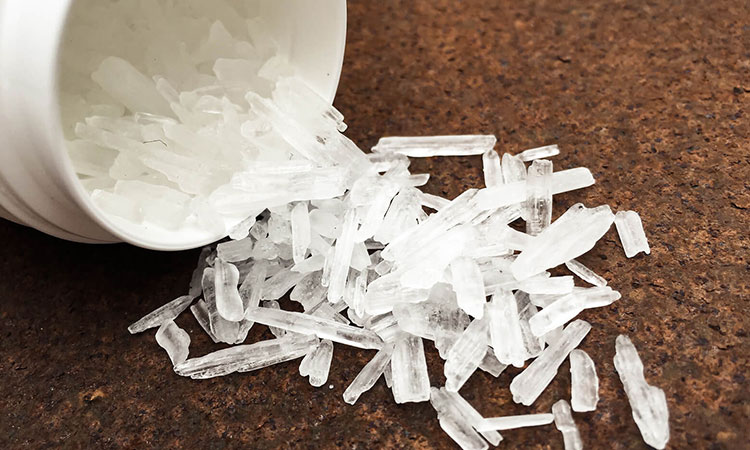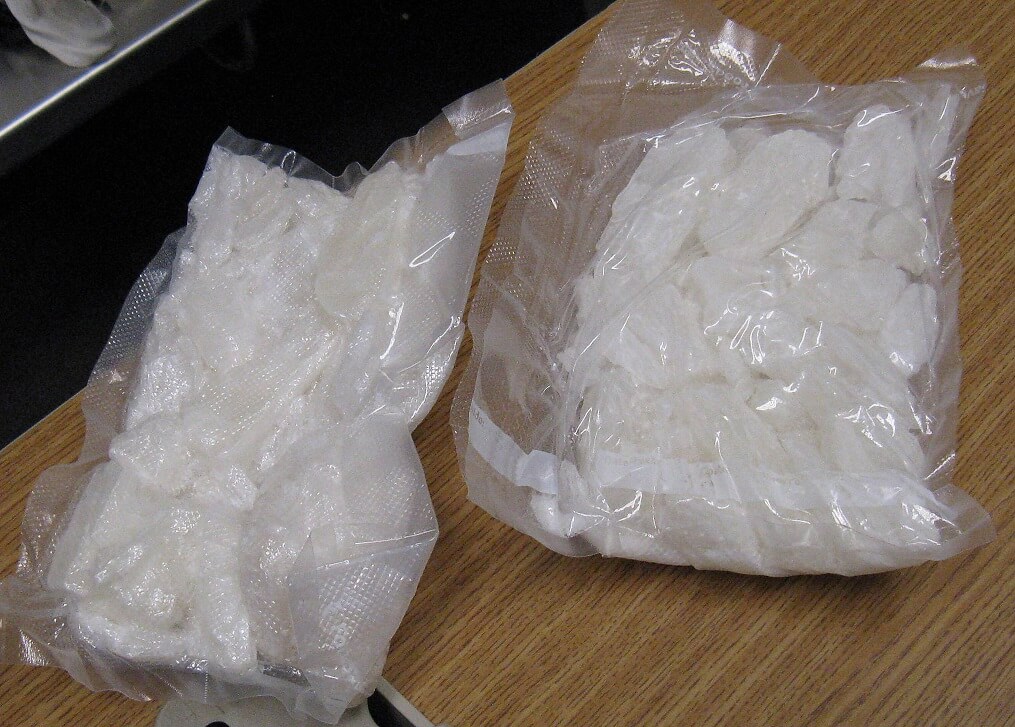
Crystal meth (methamphetamine hydrochloride) is an extremely addictive psychostimulant that affects the spinal cord, brain, and central nervous system (CNS). Depending on what form it is in, meth can either be smoked using a pipe (crystal form), snorted as a powder, dissolved in water and injected, or swallowed in tablet form.
Like cocaine, meth alters the way the brain the neurotransmitter dopamine, radically elevating dopamine concentrations. Dopamine is responsible for feelings of motivation, reward, pleasure, and euphoria. Furthermore, meth use also results in significant effects regarding the way in which the brain manages serotonin, another neurotransmitter responsible for the following:
- Feelings of affection
- Appetite
- Body temperature
- Motor functions
- Inducing sleep
- Mood and personality regulation
- Libido
Meth is predominantly available in the following forms:
Powder—This form, known as speed or crank, resembles a coarse or fine powder and if off-white or yellowish in color. Pharmaceutical grade meth powder can also be found as a tablet of the prescription medication Desoxyn, which is indicated to treat attention-deficit hyperactivity disorder (ADHD). Meth is usually least potent in this form.
Base —This form, also known as point or wax, resembles a damp, chunky, and gritty paste-like substance and is off-white, pink, yellow, or brown in color. This form is usually purer and more potent than powder.
Crystal –This form, known as crystal meth, is manufactured illegally from a combination of over-the-counter medications and toxic substances in clandestine labs in the United States and elsewhere (Mexico in particular) for recreational use. Crystal meth, which is sometimes called ice, blue ice, or glass, resembles a white or bluish-white, quartzlike rock or glass shard. Meth is usually most pure and potent in this form.
Of note, meth addiction also commonly overlaps with other substance abuse, including that which is associated with alcoholism and opioid addiction.
Crystal Meth Effects
When consumed, meth produces an intense “rush” of feelings of well-being as blood pressure, heart rate, and libido all increase. A meth rush is followed by powerful, long-lasting high.
Crystal meth is known to produce a laundry list of short-term psychological side effects, including the following:
- Nervousness and fidgeting
- Irrational irritability, aggression, or violent behavior
- Hypervigilance and paranoia
- Increased concentration and focus
- Racing thoughts
- Hyperactivity and restlessness
- Trouble sleeping
- Increased energy
- Amplified libido
- Increased sociability
- Reduced inhibitions
- Inflated self-esteem and confidence
- Delusions of grandeur and a false sense of invincibility or power
- Hallucinations
- Psychomotor agitation or tics, i.e., hair pulling or skin picking
- Obsessive or repetitive behaviors
Crystal meth also causes a myriad of short-term physical effects, including the following:
- Dilated pupils
- Blurry vision
- Diarrhea
- Constipation
- Dizziness
- Dry mouth
- Bruxism (teeth clenching and grinding)
- Acne
- Itchy skin
- Dry skin
- Hyperthermia (elevated body temperature)
- Flushing of the skin
- Headaches
- Increased blood pressure
- Numbness
- Pallor
- Excessive sweating
- Tachypnea (rapid respiration)
- Restlessness
- Twitching or tremors
- Heart palpitations or tachycardia (rapid heart rate)

The high delivered by cocaine lasts roughly between 15 and 30 minutes, for crack cocaine, only 5 to 10 minutes. In comparison, a meth rush alone can last over a half an hour, and the subsequent high persists for between eight and 24 hours. Because meth’s rush and high are so long-lasting, some prefer it to drugs like cocaine.
However, being under the influence of a substance for that long means that the body must endure any physiological stress it provokes. The human body did not evolve to handle being high on meth, especially over extended periods of repeated use. Therefore, significant physical damage, both external and internal, is inevitable for meth users over time.
Indeed, meth is infamous for causing severe dental damage and decay, commonly known as “meth mouth.” This condition happens because meth users often have a dry mouth, lacking saliva to protect teeth from the acidic ingredients used in meth production, such as battery acid, hydrochloric acid, and drain cleaner. Also, meth users regularly clench and grind their teeth, crave sugary drinks, and neglect oral hygiene completely.
Long periods of constant meth use, known as a meth binge, can lead to a condition called “tweaking,” which is often considered the most dangerous aspect of meth abuse. Tweaking is when a user binges for several days without sleep and begins to grow paranoid and unstable. Tweaking is characterized by compulsive, uncontrollable scratching, tremors, emotional volatility, paranoia, and tactile hallucinations of bugs crawling under the skin.
Crystal meth has gained in popularity among those who use it to enhance the experience of clubbing and partying. Some even consume it because it tends to cause rapid weight loss, though this weight usually returns upon cessation of meth. As well, because the user will become increasingly tolerant of meth, this weight loss effect will lessen over time.
Some also utilize meth to self-medicate depression, owing to its long-lasting mood-enhancing and euphoric properties. Others consume it solely as an aphrodisiac because it increases sexual desire and enhances sexual pleasure.
Concerning brain regions associated with dopamine production and processing, neural imaging studies have found that long-term meth abusers display structural changes serious enough to compromise their motor skills and capacity for verbal learning. Likewise, meth can disturb brain regions associated with memory and emotion. For these reasons, chronic meth abusers often develop cognitive deficits and dysregulated emotions.
Some of these neurological changes may persist long after meth abuse has ceased such as those associated with the transmission and processing of chemicals. These will gradually reverse, but this process may require more than a year of abstinence.
Physical effects caused by long-term meth use include the following:
- Increased tolerance
- Physical dependence
- Meth mouth
- Burn sores
- Sores from scratching
- Bacterial skin infections
- Premature skin aging
- Frequent nosebleeds
- Rapid, unstable weight loss or anorexia
- Malnutrition
- Dramatically increased risk of stroke and heart attack
- Cardiovascular disease
- Brain cell death and brain damage
- Kidney, liver, and lung damage
- Congenital disabilities
- Seizures
Psychological effects caused by long-term meth use include the following:
- Addiction and impulsive drug-seeking behaviors
- Psychosomatic disorders
- Insomnia
- Anxiety
- Depression
- Paranoia
- Methamphetamine psychosis
Meth users also incur many general risks associated with drug use, such as contracting HIV or hepatitis B and C, as well as overdosing. The lowered inhibitions caused by meth may lead users to inject with non-sterile needles, as well as engage in unprotected sex. Likewise, the physiological stress of meth in the body can accelerate the progression of HIV and AIDS.
Treatment for Meth Addiction
Meth addiction is a devastating condition that results in a myriad of physical, emotional, and social consequences. Fortunately, however, it can be treated using a comprehensive, evidence-based approach. Our center offers behavioral therapy, counseling, and group support, among other services, in both inpatient (residential) and outpatient formats.
Our medical and mental health professionals specialize in addiction and are available 24/7 for those undergoing detox or inpatient treatment. Regardless of format, however, they provide our clients with the tools they need to achieve a full recovery and enjoy longstanding wellness and sobriety.
Following treatment, clients can take advantage of our aftercare planning services that identify local resources outside of the center who can provide the former client with long-term psychotherapy, counseling, and support.
Our programs are structured with various components of evidence-based treatment practices and holistic approaches to treatment that provide our patients with the knowledge and tools they need to be successful in their recovery.
If you or your loved one is suffering from substance abuse, please seek help as soon as possible.
Call us now to learn about our treatment options.